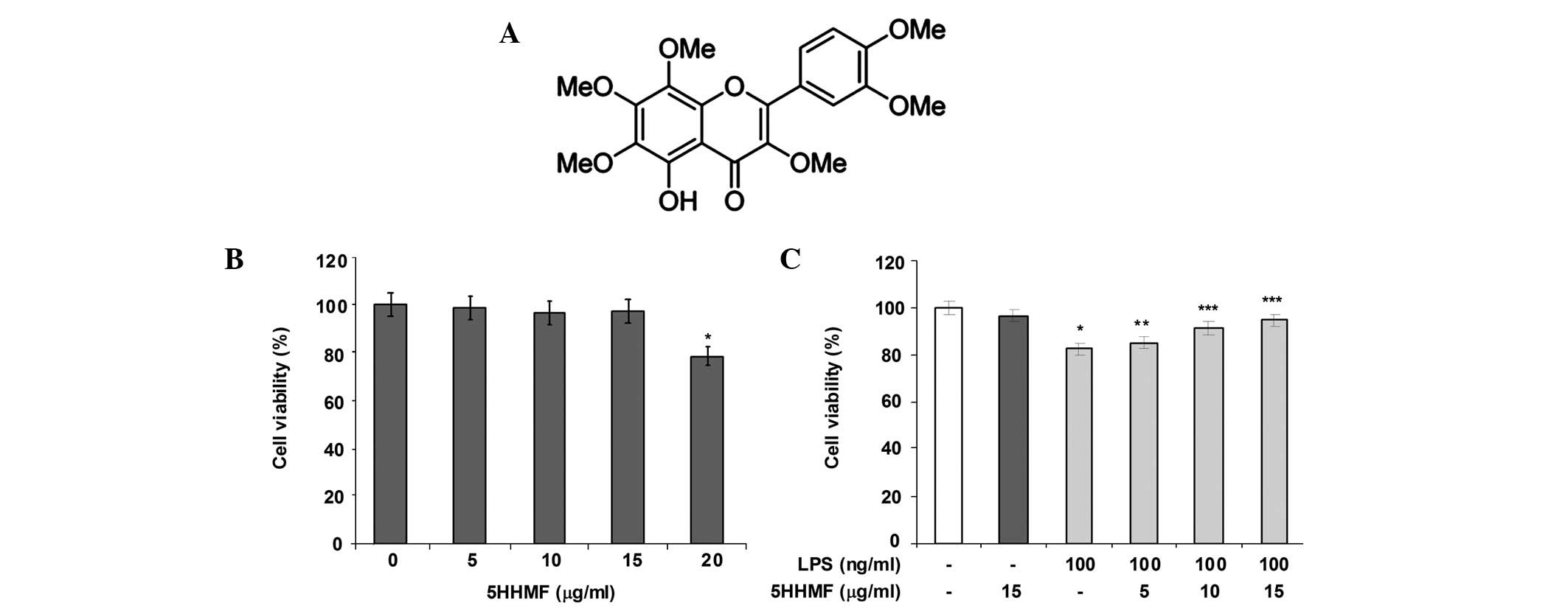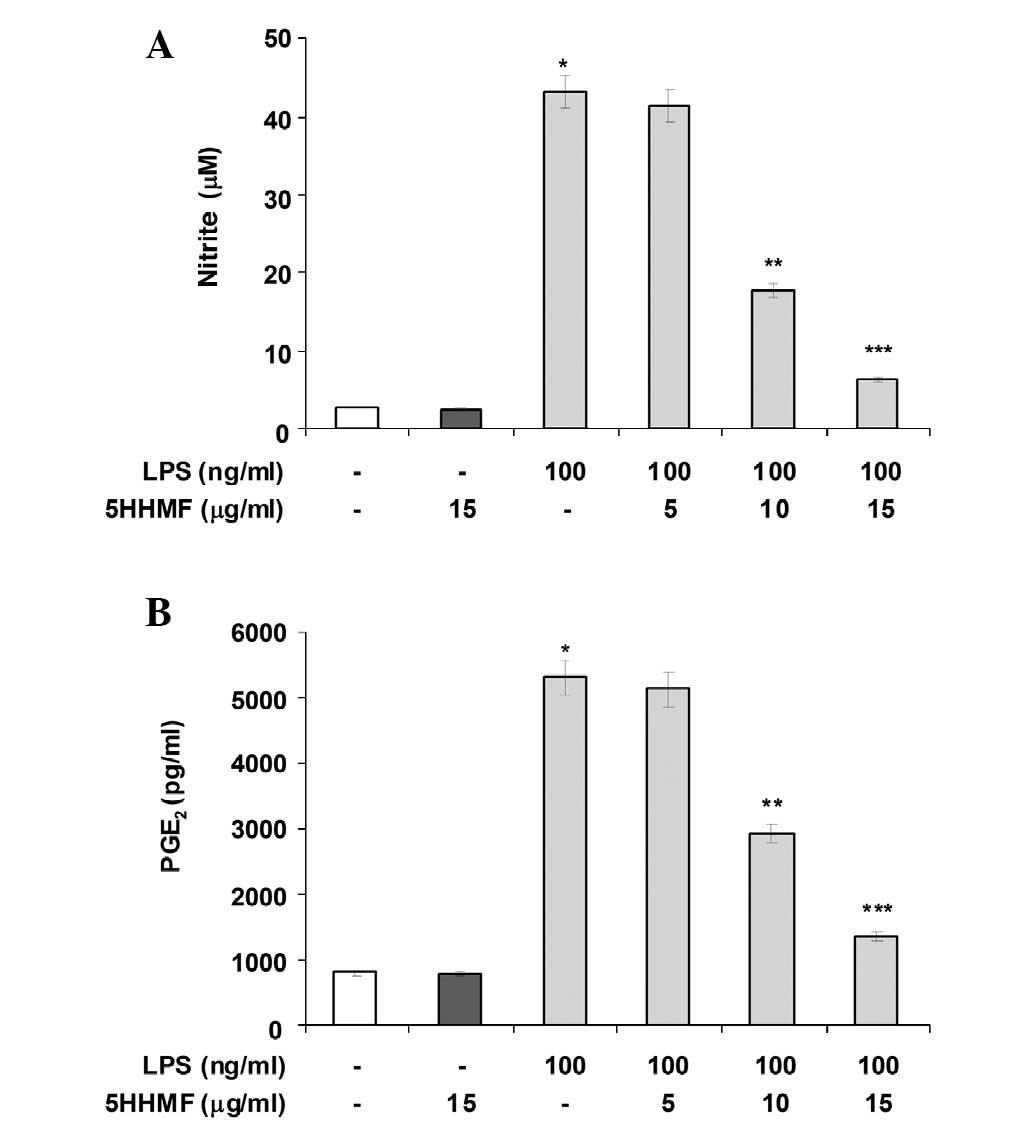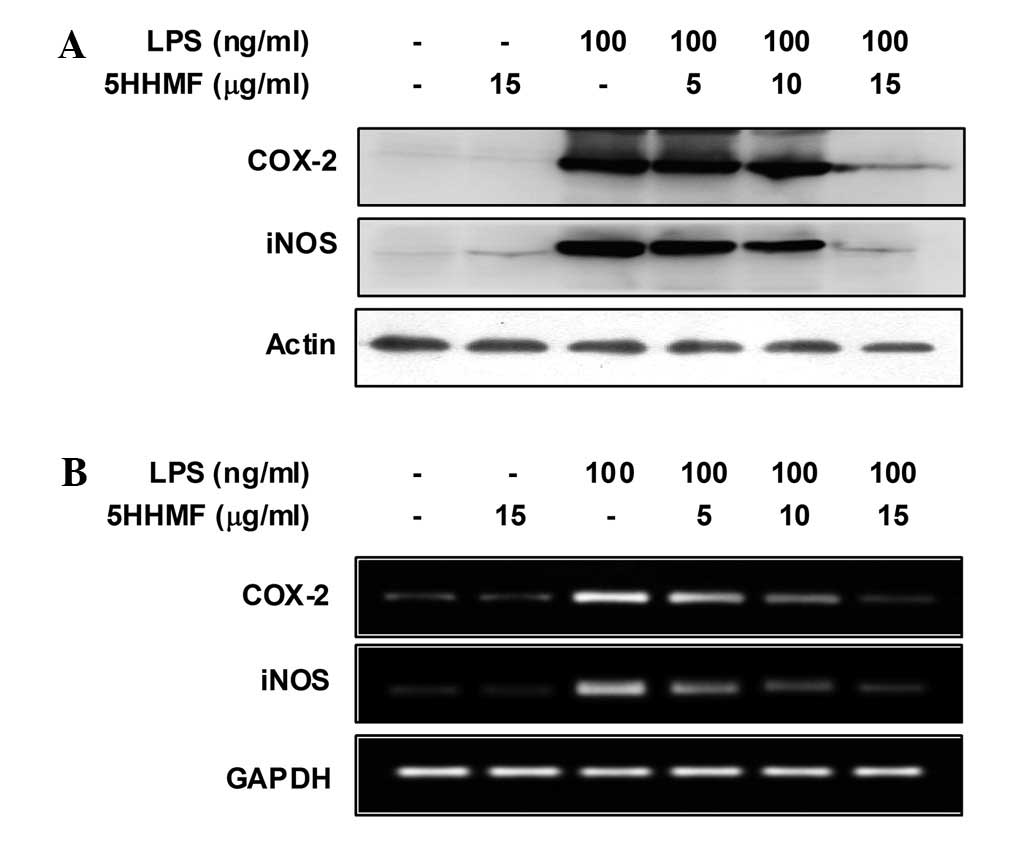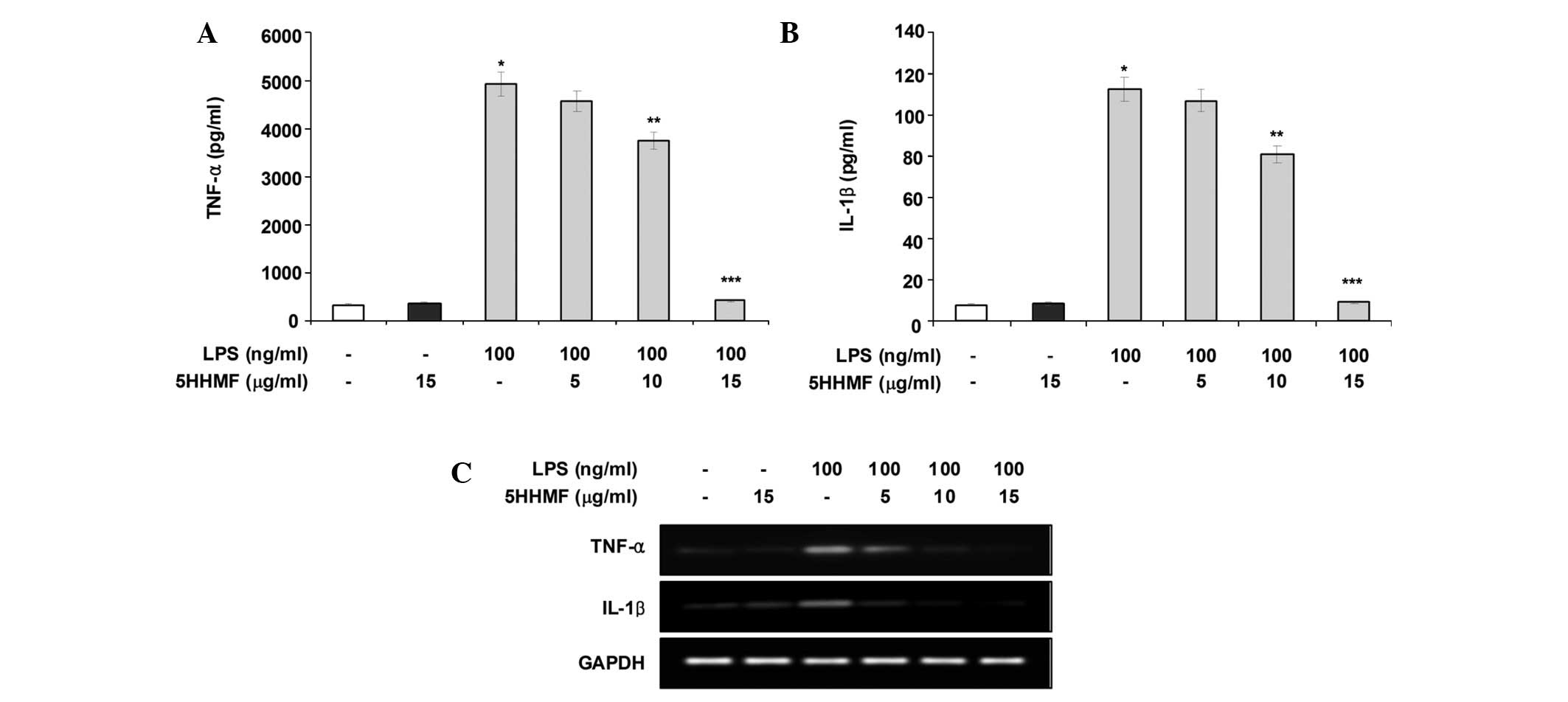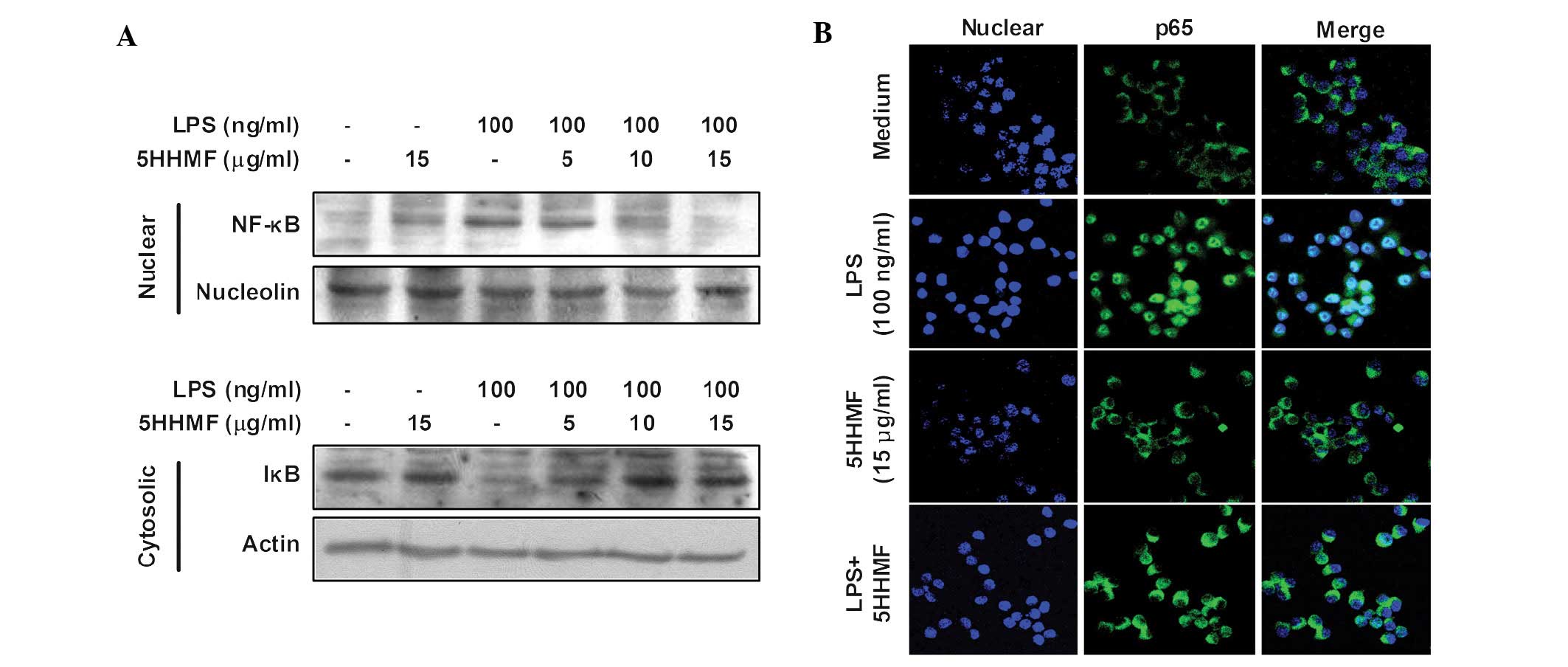Anti-inflammatory effects of 5-hydroxy-3,6,7,8,3',4'-hexamethoxyflavone via NF-κB inactivation in lipopolysaccharide-stimulated RAW 264.7 macrophage
- Authors:
- Published online on: January 28, 2014 https://doi.org/10.3892/mmr.2014.1922
- Pages: 1197-1203
Abstract
Introduction
Inflammation is crucial in mammalian physiology and is a hallmark of many human diseases, including atherosclerosis, autoimmune disorders, diabetes, chronic infection and cancer (1). In the presence of stimuli such as lipopolysaccharide (LPS), activated macrophages produce several inflammatory mediators, including nitric oxide (NO) and prostaglandin E2 (PGE2) and pro-inflammatory cytokines such as tumor necrosis factor (TNF)-α and interleukins (ILs). However, vigorous production of inflammatory cytokines may lead to septic shock and tissue damage during an infection (2,3).
Production and release of pro-inflammatory mediators and cytokines in response to LPS is dependent upon inducible gene expression, which is mediated by the activation of transcription factors including nuclear transcription factor-κB (NF-κB) and mitogen-activated protein kinases (MAPKs) (4–8). NF-κB regulates various genes involved in immune and acute phase inflammatory responses. NF-κB activation, in response to pro-inflammatory stimuli, involves the rapid phosphorylation of IκB by the IκB kinase (IKK) signalosome complex. Free NF-κB produced by this process is translocated to the nucleus where it binds to κB-binding sites in the promoter regions of target genes. It then induces the transcription of pro-signalosome mediators and cytokines (9–11). Therefore, the NF-κB activation pathway is a common target of anti-inflammatory drugs.
Effective herbal medicines have recently generated renewed interest for the production of novel therapeutic strategies to suppress pro-inflammatory mediator and cytokine production by macrophages (12–14). Hizikia fusiforme (H. fusiforme) is one of the most common edible brown seaweed species of the Sargassaceae family, and is located in the littoral zones of Korea and Japan. Findings of previous studies have suggested that crude extracts of H. fusiforme possess a variety of biologically active compounds, particularly antioxidants, immuno-modulators and anticoagulants (15–18). We have previously demonstrated that 5-hydroxy-3,6,7,8,3′,4′-hexamethoxyflavone (5HHMF, Fig. 1A), isolated from H. fusiforme extracts, potently induces apoptosis in human AGS carcinoma cells (19). In addition, 5HHMF and its derivative 3′-hydroxy-5,6,7,4′-tetramethoxyflavone, exhibit more potent inhibitory effects on the growth of human leukemia and breast cancer cells than their permethoxylated counterparts, HMF and 5,6,7,3′,4′-pentamethoxyflavone, respectively (20,21). However, the anti-inflammatory activity of 5HHMF has not yet been elucidated. The aim of the present study was to investigate whether 5HHMF inhibited the production and expression of inflammatory mediators and cytokines in LPS-stimulated RAW 264.7 murine macrophage cells. To the best of our knowledge, this is the first study to investigate this and the results demonstrated that the anti-inflammatory effects of 5HHMF are achieved by inhibition of the nuclear translocation of NF-κB by preventing IκB-α degradation.
Materials and methods
Reagents
LPS (Escherichia coli 026:B6), Griess reagent, Tween-20, bovine serum albumin and MTT were purchased from Sigma-Aldrich (St. Louis, MO, USA). Dulbecco’s modified Eagle’s medium (DMEM), fetal bovine serum (FBS) and other tissue culture reagents were purchased from Gibco-BRL (Grand Island, NY, USA). Other chemicals were obtained from Sigma-Aldrich unless otherwise indicated.
Cell culture
The RAW 264.7 cell line, which was derived from murine macrophages, was obtained from the American Type Culture Collection (Manassas, VA, USA). These cells were maintained in DMEM medium, supplemented with 10% FBS, 100 U/ml penicillin and 100 μg/ml streptomycin, at 37°C in a 5% CO2 humidified air environment. Previously purified 5HHMF (19) was used in this study. The 5HHMF was dissolved in dimethyl sulfoxide (DMSO) to produce a 10 mg/ml stock solution and then adjusted to final concentrations using complete DMEM.
Cell viability assay
Cell viability was evaluated by the MTT assay. RAW 264.7 cells were seeded into 96-well plates at a density of 4×103 cells/well and maintained at 37°C for 24 h. The cells were exposed to various concentrations of 5HHMF (0, 5, 10 and 15 μg/ml) for 1 h and stimulated with LPS (100 ng/ml). After 24 h of incubation, the MTT (0.5 mg/ml in phosphate-buffered saline, PBS) solution was added to each well and incubated for another 3 h. The formazan crystals were dissolved in 200 μl DMSO and the cell viability was determined subsequent to measuring the absorbance at a wavelength of 540 nm with a microplate reader (Dynatech MR-7000; Dynatech Laboratories Inc., Chantilly, VA, USA).
Measurement of NO and PGE2 production
The nitrite concentration in the medium was measured according to the Griess reaction and the calculated concentration was taken as an indicator of NO production. The supernatant of cell cultures was mixed with an equal volume of Griess reagent (1% sulfanilamide in 5% phosphoric acid and 0.1% naphthylethylenediamine dihydrochloride in water). The optical density at 540 nm was measured and calculated against a sodium nitrite standard curve. The accumulated PGE2 in the culture medium was measured using a PGE2 enzyme-linked immunosorbent assay (ELISA) kit (Cayman Chemical, Ann Arbor, MI, USA), according to the manufacturer’s instructions.
Measurement of pro-inflammatory cytokine production
The inhibitory effect of 5HHMF on the production of pro-inflammatory cytokines, TNF-α and IL-1β, from LPS-treated RAW 264.7 cells was determined using a mouse ELISA kit (R&D Systems, Minneapolis, MN, USA), as described previously (22).
Reverse transcriptase PCR (RT-PCR)
Total RNA was isolated using TRIzol reagent (Invitrogen Life Technologies, Carlsbad, CA, USA). The total RNA (1 μg) obtained from the cells was reverse-transcribed using M-MLV Reverse Transcriptase (Promega Corporation, Madison, WI, USA) to produce cDNA. RT-generated cDNA encoding iNOS, COX-2, TNF-α, IL-1β and glyceraldehyde 3-phosphate dehydrogenase (GAPDH) genes was amplified by PCR using selective primers (Table I). Subsequent to amplification, aliquots of the PCR reaction mixture were electrophoresed on an agarose gel.
Western blot analysis
The cells were washed with PBS three times and lysed with a lysis buffer (1% Triton X-100, 1% deoxycholate and 0.1% NaN3) containing protease inhibitor cocktail tablets (Roche Diagnostics GmbH, Mannheim, Germany). Equal quantities of protein were separated on 10% sodium dodecyl sulfate-polyacrylamide mini-gels and transferred to Immobilon polyvinylidene difluoride membranes (Millipore, Milford, MA, USA). Subsequent to incubation with the appropriate primary antibody, the membrane was hybridized with secondary antibody conjugated to horseradish peroxidase for 1 h at room temperature. Following three washes with Tris-buffered saline with Tween-20, immunoreactive bands were visualized using the Enhanced Chemiluminescence Detection system (Pierce Biotechnology Inc., Rockford, IL, USA). In a parallel experiment, nuclear protein was prepared using nuclear extraction reagents (Pierce Biotechnology Inc.), according to the manufacturer’s instructions.
Confocal laser scanning microscopy study
NF-κB p65 nuclear localization was detected by indirect immunofluorescence assays using confocal microscopy. RAW 264.7 cells were cultured directly on glass coverslips in 6-well plates for 24 h. Subsequent to stimulation with 100 ng/ml LPS and/or 15 μg/ml 5HHMF, the cells were fixed with 4% paraformaldehyde in PBS, permeabilized with 0.2% Triton X-100 in PBS and blocked with 1.5% normal donkey serum (Sigma-Aldrich). A polyclonal antibody against NF-κB p65 (1 μg/well) was applied for 1 h followed by a 1 h incubation with fluorescein isothiocyanate-conjugated donkey anti-rabbit IgG (Jackson ImmunoResearch Laboratories, Inc., West Grove, PA, USA). After washing with PBS, the coverslips were mounted in Fluoromount-G™ (Southern Biotechnology Associates Inc., Birmingham, AL, USA) and fluorescence was visualized using a Zeiss LSM 510 laser scanning confocal device attached to an Axiovert 100 microscope using a Plan-Apochromat ×100 Oil DIC objective (Carl Zeiss, Oberkochen, Germany) (23).
Statistical analysis
Data are presented as the mean ± SD. Statistical significance was determined using analysis of variance followed by Student’s t-test. P<0.05 was considered to indicate a statistically significant difference.
Results
Protective effect of 5HHMF on LPS-induced cytotoxicity
The protective effect of 5HHMF was initially investigated based on LPS-induced cytotoxicity of RAW 264.7 cells using an MTT assay. As shown in Fig. 1C, LPS (100 ng/ml) treatment significantly induced cytotoxicity compared with that observed in the unstimulated control cells. However, the growth of LPS-stimulated RAW 264.7 cells was significantly enhanced by 5HHMF in a dose-dependent manner. Moreover, 5, 10 and 15 μg/ml concentrations of 5HHMF exhibited a protective effect on LPS-stimulated cytotoxicity in RAW 264.7 cells. However, 5HHMF alone did not show any obvious cytotoxic effect at the concentrations of 5–15 μg/ml (Fig. 1B).
Effect of 5HHMF on NO and PGE2 production in LPS-stimulated RAW 264.7 cells
Pro-inflammatory mediators such as NO and PGE2 are important in the inflammatory response. To determine the level of NO production, nitrite released into the culture medium was measured using Griess reagent. As shown in Fig. 2A, LPS alone markedly induced NO production in the cells compared with that in the control. However, pre-treatment with 5HHMF (up to 15 μg/ml) significantly repressed the levels of NO production in LPS-stimulated RAW 264.7 cells in a concentration-dependent manner (Fig. 2A). The effects of 5HHMF on the production of PGE2, another important inflammatory mediator, was also investigated in LPS-stimulated RAW 264.7 cells. As shown in Fig. 2B, treatment of RAW 264.7 cells with LPS resulted in a marked increase in PGE2 release compared with that in the untreated control after 24 h of exposure to LPS. However, 5HHMF inhibited LPS-mediated PGE2 production in a concentration-dependent manner at the concentrations tested. These results suggest that pretreatment with 5HHMF results in significant suppression of the expression of LPS-mediated pro-inflammatory mediators.
Effect of 5HHMF on LPS-stimulated iNOS and COX-2 expression
To elucidate the mechanism involved in the inhibition of NO and PGE2 by 5HHMF in LPS-stimulated RAW 264.7 cells, the effect of 5HHMF on iNOS and COX-2 protein and gene expression levels was investigated by western blot and RT-PCR analyses (Fig. 3). iNOS and COX-2 protein and mRNA expression in unstimulated RAW 264.7 cells was marginally detectable. However, iNOS and COX-2 expression increased markedly in response to LPS, and 5HHMF significantly inhibited the iNOS and COX-2 proteins in a dose-dependent manner (Fig. 3A). Under the same conditions, the levels of iNOS and COX-2 mRNA expression were correlated with their protein levels (Fig. 3B). These results indicated that reduced expression of iNOS and COX-2 by 5HHMF was responsible for inhibiting NO and PGE2 production.
Effect of 5HHMF on TNF-α and IL-1β production and expression in LPS-stimulated RAW 264.7 cells
As 5HHMF potently inhibited the pro-inflammatory mediators NO and PGE2, its effects on LPS-stimulated pro-inflammatory cytokines, such as TNF-α and IL-1β, were investigated by an enzyme immunoassay and RT-PCR analysis. As shown in Fig. 4A and B, TNF-α and IL-1β levels increased significantly in the culture media of LPS-stimulated RAW 264.7 cells. However, pre-treatment with 5HHMF significantly decreased the release of these pro-inflammatory cytokines in a concentration-dependent manner. In addition, the TNF-α and IL-1β mRNA levels induced by LPS decreased significantly in a concentration-dependent manner following 5HHMF treatment (Fig. 4C). These results suggested that 5HHMF is effective in suppressing pro-inflammatory cytokine production by altering TNF-α and IL-1β transcription levels in activated RAW 264.7 cells.
Inhibition of NF-κB activation by 5HHMF in LPS-stimulated RAW 264.7 cells
Previous studies have suggested that NF-κB is an important transcription factor that regulates iNOS, COX-2 and inflammatory cytokine expression (24,25). A number of the predominant mechanisms involving the activation of NF-κB include the phosphorylation of IKK and degradation of IκB-α, which allow the release of free NF-κB and its translocation into the nucleus (26). To investigate whether 5HHMF regulates the NF-κB pathway, we investigated whether 5HHMF prevented the translocation of the NF-κB p65 subunit to the nucleus. Western blot analysis showed that the quantity of NF-κB p65 in the nucleus increased markedly following exposure to LPS alone; however, the LPS-induced p65 level in the nuclear fractions decreased following 5HHMF pre-treatment. In addition, western blot analysis was used to investigate whether 5HHMF blocked LPS-stimulated degradation of IκB-α. As shown in Fig. 5A, IκB-α was markedly degraded 15 min after LPS treatment. This LPS-induced IκB-α degradation was significantly reversed by 5HHMF. Furthermore, the translocation of NF-κB to the nucleus in RAW 264.7 cells was analyzed using immunofluorescence staining and confocal microscopy to clearly understand the effect of 5HHMF on NF-κB p65 nuclear translocation (Fig. 5B). The confocal images revealed that NF-κB p65 was normally sequestered in the cytoplasm (Fig. 5B, middle panel), and that nuclear accumulation of NF-κB p65 was markedly induced following the stimulation of RAW 264.7 cells with LPS (Fig. 5B, LPS panel). The LPS-induced translocation of NF-κB p65 was completely eliminated subsequent to pre-treating the cells with 5HHMF (Fig. 5B, LPS+5HHMF panel). Nuclear translocation of NF-κB p65 was not induced in the cells following pre-treatment with 5HHMF alone, in the absence of LPS stimulation (Fig. 5B, 5HHMF panel). Thus, these results demonstrated that the anti-inflammatory effect of 5HHMF in LPS-stimulated RAW 264.7 cells involves the NF-κB pathway.
Discussion
The results of ther present study have demonstrated that 5HHMF exhibits pharmacological and biological activities via significant inhibitory effects on the production of the LPS-induced pro-inflammatory mediators, such as iNOS and COX-2, as well as cytokines (including TNF-α and IL-1β) in activated RAW 264.7 cells. These effects were accompanied by the downregulation of NF-κB activation.
Macrophages produce NO and pro-inflammatory cytokines in response to bacterial LPS. This NO production is controlled by selective pharmacological inhibition of distinct NO synthase isoforms (27,28). iNOS is one of three key enzymes that generate NO from arginine. NO is pivotal in numerous body functions; however, its overproduction in macrophages, in particular, leads to cytotoxicity, inflammation and autoimmune disorders (6). Therefore, NO inhibitors are essential for preventing inflammatory diseases. PGE2 is considered an important mediator in the processes of inflammation produced by COX-2 (29). As a result, a detailed understanding of the intracellular mechanisms of the expression of inflammatory mediators and the effects of inhibiting those inflammatory mediators is important to identify therapeutic strategies for inflammatory diseases. In the present study, 5HHMF significantly suppressed LPS-stimulated NO and PGE2 production in RAW 264.7 cells in a concentration-dependent manner, which appeared to be due to the transcriptional suppression of COX-2 and iNOS. The results of the present study also indicated that 5HHMF suppressed the production of the pro-inflammatory cytokines TNF-α and IL-1β. These cytokines are key in the induction of inflammation in macrophages (28,30). TNF-α exhibits its pro-inflammatory activity by regulating several intercellular and vascular cell adhesion molecules, which results in the recruitment of leukocytes to sites of inflammation (31). IL-1β is also a key pro-inflammatory cytokine that is released from immune responding cells when stimulated by LPS (32). Thus, inhibition of cytokine production or function may be considered a key mechanism in RAW 264.7 cells. Treatment with 5HHMF prior to LPS stimulation significantly attenuated the production of cytokines in RAW 264.7 cells. Therefore, the inhibitory effect of 5HHMF on inflammatory mediator expression aided in the identification of one of the mechanisms responsible for its anti-inflammatory action and suggests that 5HHMF is a potential therapeutic agent for treating LPS-induced sepsis syndrome.
Bacterial pathogens such as LPS stimulate the transcription of genes involved in the inflammatory and immune responses, including the NF-κB pathway (33). NF-κB is activated by phosphorylation, ubiquitination and subsequent proteolytic degradation of NF-κB-bound IκB via activated IκB kinase (34). The excreted NF-κB transcription factor then translocates to the nucleus and binds to NF-κB motifs in the promoters of target genes such as those encoding iNOS, COX-2 and cytokines to promote transcription (35). The results of the present study suggest that 5HHMF significantly inhibits the LPS-stimulated nuclear translocation of p65 in RAW 264.7 macrophages. Thus, the potential inhibition of cytokine production by 5HHMF is in accordance with the inhibition of NF-κB-dependent cytokines and reduced inflammation. Although inhibiting NF-κB activation has been proposed as a therapeutic approach for sepsis, NF-κB is an essential component of normal host defenses and blocking the regulatory actions of NF-κB may result in severe immunosuppression (36).
In conclusion, the results of the present study have demonstrated that 5HHMF treatment results in a decrease of pro-inflammatory mediators following LPS stimulation in RAW 264.7 cells. 5HHMF also significantly inhibited the release of TNF-α and IL-1β and decreased their mRNA expression levels in a dose-dependent manner. In addition, the anti-inflammatory properties of 5HHMF were mediated by the downregulation of NF-κB activation. Therefore, 5HHMF is a potential therapeutic agent for patients with, or at risk of, septic shock and other inflammatory diseases.
Acknowledgements
This study was supported by the Technology Development Program for Agriculture and Forestry (grant no. 610003-03-1-SB110), Ministry for Food, Agriculture, Forestry and Fisheries, Republic of Korea.
References
|
Andreasen AS, Krabbe KS, Krogh-Madsen R, Taudorf S, Pedersen BK and Møller K: Human endotoxemia as a model of systemic inflammation. Curr Med Chem. 15:1697–1705. 2008. View Article : Google Scholar : PubMed/NCBI | |
|
Aderem A: Role of Toll-like receptors in inflammatory response in macrophages. Crit Care Med. 29(Suppl 7): S16–S18. 2001. View Article : Google Scholar : PubMed/NCBI | |
|
Ritchlin CT, Haas-Smith SA, Li P, Hicks DG and Schwarz EM: Mechanisms of TNF-alpha- and RANKL-mediated osteoclastogenesis and bone resorption in psoriatic arthritis. J Clin Invest. 111:821–831. 2003. View Article : Google Scholar : PubMed/NCBI | |
|
Brown MD and Sacks DB: Compartmentalised MAPK pathways. Handb Exp Pharmacol. 186:205–235. 2008. View Article : Google Scholar | |
|
Ci X, Song Y, Zeng F, Zhang X, Li H, Wang X, Cui J and Deng X: Ceftiofur impairs pro-inflammatory cytokine secretion through the inhibition of the activation of NF-κB and MAPK. Biochem Biophys Res Commun. 372:73–77. 2008.PubMed/NCBI | |
|
Liu RH and Hotchkiss JH: Potential genotoxicity of chronically elevated nitric oxide: a review. Mutat Res. 339:73–89. 1995. View Article : Google Scholar : PubMed/NCBI | |
|
Siebenlist U, Franzoso G and Brown K: Structure, regulation and function of NF-kappa B. Annu Rev Cell Biol. 10:405–455. 1994. View Article : Google Scholar : PubMed/NCBI | |
|
Zhang X, Li H, Feng H, Xiong H, Zhang L, Song Y, Yu L and Deng X: Valnemulin downregulates nitric oxide, prostaglandin E2, and cytokine production via inhibition of NF-kappaB and MAPK activity. Int Immunopharmacol. 9:810–816. 2009. View Article : Google Scholar : PubMed/NCBI | |
|
Edwards MR, Bartlett NW, Clarke D, Birrell M, Belvisi M and Johnston SL: Targeting the NF-kappaB pathway in asthma and chronic obstructive pulmonary disease. Pharmacol Ther. 121:1–13. 2009. View Article : Google Scholar : PubMed/NCBI | |
|
Ghosh S and Hayden MS: New regulators of NF-kappaB in inflammation. Nat Rev Immunol. 8:837–848. 2008. View Article : Google Scholar : PubMed/NCBI | |
|
Wong ET and Tergaonkar V: Roles of NF-kappaB in health and disease: mechanisms and therapeutic potential. Clin Sci (Lond). 116:451–465. 2009. View Article : Google Scholar : PubMed/NCBI | |
|
Barak V, Kalickman I, Halperin T, Birkenfeld S and Ginsburg I: PADMA-28, a Tibetan herbal preparation is an inhibitor of inflammatory cytokine production. Eur Cytokine Netw. 15:203–209. 2004.PubMed/NCBI | |
|
Chi YS, Lim H, Park H and Kim HP: Effects of wogonin, a plant flavone from Scutellaria radix, on skin inflammation: in vivo regulation of inflammation-associated gene expression. Biochem Pharmacol. 66:1271–1278. 2003.PubMed/NCBI | |
|
Genovese MC: Biologic therapies in clinical development for the treatment of rheumatoid arthritis. J Clin Rheumatol. 11:S45–S54. 2005. View Article : Google Scholar : PubMed/NCBI | |
|
Kim KI, Seo HD, Lee HS, Jo HY and Yang HC: Studies on the blood anticoagulant polysaccharide isolated from hot water extracts of Hizikia fusiforme. Korean J Food Sci Nutr. 27:1204–1210. 1998. | |
|
Nagai T and Yukimoto T: Preparation and functional properties of beverages made from sea algae. Food Chem. 81:327–332. 2003. View Article : Google Scholar | |
|
Okai Y, Okai KH, Ishizaka S, Ohtani K, Yuasa IS and Yamashita U: Possible immunodulating activities in extract of edible brown alga Hizikia fusiforme (Hiziki). J Food Agricul. 76:56–62. 1998. View Article : Google Scholar | |
|
Yan X, Chuda Y, Suzuki M and Nagata T: Fucoxanthin as the major antioxidant in Hijikia fusiformis, a common edible seaweed. Biosci Biotechnol Biochem. 63:605–607. 1999. View Article : Google Scholar : PubMed/NCBI | |
|
Kim MJ, Lee HH, Seo MJ, Kang BW, Park JU, Kim KS, Kim KY, Joo WH, Choi YH, Cho YS and Jeong YK: Identification of 5-hydroxy-3,6,7,8,3′,4′-hexamethoxyflavone from Hizikia fusiforme involved in the induction of the apoptosis mediators in human AGS carcinoma cells. J Microbiol Biotechnol. 22:1665–1672. 2012. | |
|
Pan MH, Lai YS, Lai CS, Wang YJ, Li S, Lo CY, Dushenkov S and Ho CT: 5-Hydroxy-3,6,7,8,3′,4′-hexamethoxyflavone induces apoptosis through reactive oxygen species production, growth arrest and DNA damage-inducible gene 153 expression, and caspase activation in human leukemia cells. J Agric Food Chem. 55:5081–5091. 2007. | |
|
Sergeev IN, Li S, Colby J, Ho CT and Dushenkov S: Polymethoxylated flavones induce Ca2+-mediated apoptosis in breast cancer cells. Life Sci. 80:245–253. 2006. View Article : Google Scholar : PubMed/NCBI | |
|
Bae DS, Kim YH, Pan CH, Nho CW, Samdan J, Yansan J and Lee JK: Protopine reduces the inflammatory activity of lipopolysaccharide-stimulated murine macrophages. BMB Rep. 5:108–113. 2012.PubMed/NCBI | |
|
Lee YH, Jeon SH, Kim SH, Kim C, Lee SJ, Koh D, Lim Y, Ha K and Shin SY: A new synthetic chalcone derivative, 2-hydroxy-3′,5,5′-trimethoxychalcone (DK-139), suppresses the Toll-like receptor 4-mediated inflammatory response through inhibition of the Akt/NF-κB pathway in BV2 microglial cells. Exp Mol Med. 44:369–377. 2012.PubMed/NCBI | |
|
Guo LY, Hung TM, Bae KH, Shin EM, Zhou HY, Hong YN, Kang SS, Kim HP and Kim YS: Anti-inflammatory effects of schisandrin isolated from the fruit of Schisandra chinensis Baill. Eur J Pharmacol. 591:293–299. 2008. View Article : Google Scholar : PubMed/NCBI | |
|
Southan GJ and Szabó C: Selective pharmacological inhibition of distinct nitric oxide synthase isoforms. Biochem Pharmacol. 51:383–394. 1996. View Article : Google Scholar : PubMed/NCBI | |
|
Plummer SM, Holloway KA, Manson MM, Munks RJ, Kaptein A, Farrow S and Howells L: Inhibition of cyclo-oxygenase 2 expression in colon cells by the chemopreventive agent curcumin involves inhibition of NF-kappaB activation via the NIK/IKK signalling complex. Oncogene. 18:6013–6020. 1999. View Article : Google Scholar : PubMed/NCBI | |
|
Sarkar D, Saha P, Gamre S, Bhattacharjee S, Hariharan C, Ganguly S, Sen R, Mandal G, Chattopadhyay S, Majumdar S and Chatterjee M: Anti-inflammatory effect of allylpyrocatechol in LPS-induced macrophages is mediated by suppression of iNOS and COX-2 via the NF-kappaB pathway. Int Immunopharmacol. 8:1264–1271. 2008. View Article : Google Scholar : PubMed/NCBI | |
|
Tao JY, Zheng GH, Zhao L, Wu JG, Zhang XY, Zhang SL, Huang ZJ, Xiong FL and Li CM: Anti-inflammatory effects of ethyl acetate fraction from Melilotus suaveolens Ledeb on LPS-stimulated RAW 264.7 cells. J Ethnopharmacol. 123:97–105. 2009. View Article : Google Scholar : PubMed/NCBI | |
|
Van Q, Nayak BN, Reimer M, Jones PJ, Fulcher RG and Rempel CB: Anti-inflammatory effect of Inonotus obliquus, Polygala senega L, and Viburnum trilobum in a cell screening assay. J Ethnopharmacol. 125:487–493. 2009. | |
|
Yun KJ, Kim JY, Kim JB, Lee KW, Jeong SY, Park HJ, Jung HJ, Cho YW, Yun K and Lee KT: Inhibition of LPS-induced NO and PGE2 production by asiatic acid via NF-kappa B inactivation in RAW 264.7 macrophages: possible involvement of the IKK and MAPK pathways. Int Immunopharmacol. 8:431–441. 2008. View Article : Google Scholar : PubMed/NCBI | |
|
Aggarwal BB and Natarajan K: Tumor necrosis factors: developments during the last decade. Eur Cytokine Netw. 7:93–124. 1996.PubMed/NCBI | |
|
Lee HS, Ryu DS, Lee GS and Lee DS: Anti-inflammatory effects of dichloromethane fraction from Orostachys japonicus in RAW 264.7 cells: suppression of NF-kappaB activation and MAPK signaling. J Ethnopharmacol. 140:271–276. 2012.PubMed/NCBI | |
|
Kim YG, Ohta T, Takahashi T, Kushiro A, Nomoto K, Yokokura T, Okada N and Danbara H: Probiotic Lactobacillus casei activates innate immunity via NF-kappaB and p38 MAP kinase signaling pathways. Microbes Infect. 8:994–1005. 2006. | |
|
Rajapakse N, Kim MM, Mendis E and Kim SK: Inhibition of inducible nitric oxide synthase and cyclooxygenase-2 in lipopolysaccharide-stimulated RAW264.7 cells by carboxybutyrylated glucosamine takes place via down-regulation of mitogen-activated protein kinase-mediated nuclear factor-kappaB signaling. Immunology. 123:348–357. 2008. | |
|
Lee SJ, Bai SK, Lee KS, Namkoong S, Na HJ, Ha KS, Han JA, Yim SV, Chang K, Kwon YG, et al: Astaxanthin inhibits nitric oxide production and inflammatory gene expression by suppressing IκB kinase-dependent NF-kappaB activation. Mol Cells. 16:97–105. 2003.PubMed/NCBI | |
|
Abraham E: Nuclear factor-kappaB and its role in sepsis-associated organ failure. J Infect Dis. 187(Suppl 2): S364–S369. 2003. View Article : Google Scholar : PubMed/NCBI |



